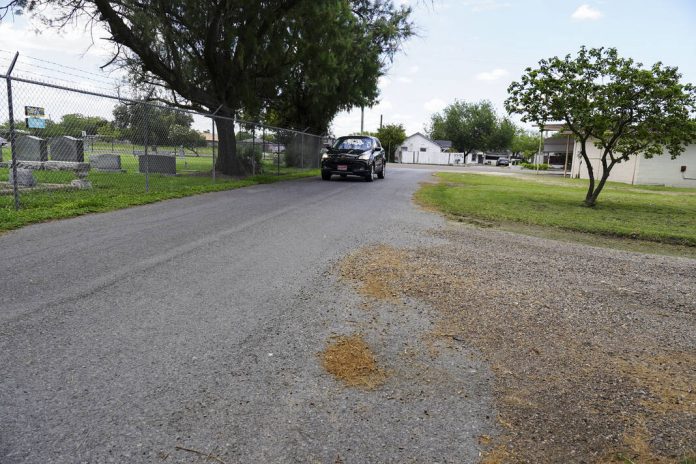
A car drives over cracked asphalt Friday at Garfield Avenue in Harlingen.(Denise Cathey/The Brownsville Herald)
HARLINGEN — The supply chain crisis’ soaring asphalt costs will likely cut into the city’s annual $2.5 million street paving project.
Across the country, the coronavirus pandemic’s economic slowdown led to production cuts in petroleum-based products, steel and other materials, driving up demand spurring surging costs.
The rocketing cost of oil, from which asphalt is made, is driving up the construction material’s price as much as 80 percent, City Commissioner Michael Mezmar warned commissioners as they tapped streets for the next fiscal year’s project.
“There’s no doubt the price will be higher than it would have been,” Assistant City Manager Craig Cook said Friday. “Our budget and estimate are about the same price but the estimate may not reflect current or future prices of asphalt. We will do what we can afford and streets we don’t do will be added to next year’s list. Think of it as one long list.”
But officials will not know the impact of the rising costs until they go out for construction bids this summer, he said.
During a meeting, Mezmar said soaring asphalt prices could lead to cuts in next year’s street project.
“How much has the price of asphalt gone up with the price of oil and petrol?” he asked Cook during Wednesday’s meeting. “I’m guessing 50 to 80 percent so we may pave less footage of roads.”
Amid discussion, commissioners approved the project aiming to pave about 7.8 miles along 12 streets.
“Let’s find out how much we can do right now with what we have because the following year it’s only going to get tougher and tougher to get just the materials,” Commissioner Richard Uribe told officials.
Residents call for repairs along Palm Court Drive
During discussion, Commissioner Rene Perez, who oversees District 5, proposed paving a stretch of Palm Court Drive instead of Brennaman Road from Stuart Place Road to Dilworth Road.
“I drove around my district looking at the specific streets from my district that were going to get worked on,” he told commissioners. “One I’ve been getting a lot of calls from is South Palm Court Drive from Garrett Road all the way to Plumeria Lane. From my opinion and from a lot of the feedback I’ve received from the community, it’s a lot worse in wear and tear. On South Palm Court, that’s one of the growing areas in my district. Subdivisions are being built, all these new homes and new families and new homes being built. I think we’d get more bang for our buck if we did that because it would be providing better roads for a larger group of people.”
In response, Cook said officials would consider the request.
Proposal to distribute work within district map
Amid discussions, Uribe proposed evenly distributing street work within the city’s five single-member districts.
“I’d like to see some kind of calculations where every district is represented equally because they’re all paying the same tax,” he told officials. “What I don’t want to see is if like District 2 or District 3 got skipped over on a cycle. As long as we’re distributing the money equally every year, that every district gets something.”
Officials planning new street review system
Every year, officials turn to criteria such as street conditions and traffic volume to pick roadways for paving.
Now, they are planning a new system, Cook said.
“We are trying to get under contract a firm that will come in and assess all of our streets,” he told commissioners. “Much like Google Earth drives around and takes pictures of buildings, this company takes pictures of roads and assesses them on a scale of one to 20 and when we get that list we will prioritize the really bad ones from the really good ones and create more lists.”
Background
The city is funding most of the project through a so-called street maintenance fee commissioners passed in 2017.
Now, the surcharge appearing on residents’ monthly utility bills is raising about $1.5 million a year.




